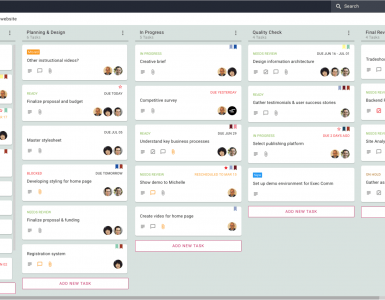
What is Angular?
Basically, Angular is a well-known front-end JavaScript framework for app development. As a platform, Angular has a component-based framework for creating scalable web apps and a set of well-integrated archives that cover a wide range of features. Angular developers are in high demand as the technology grows in popularity, so how do you stand out in the interview process? Do you know the latest Angular interview questions?
Fear not. This article will talk about some of the most common Angular interview questions and how to answer them. No matter whether you’re a beginner or a complete expert, this guide will break it down from interview start to interview end.
Ready? Let’s dive in.
The Basic Angular Interview Questions & Answers
1. What exactly is Angular? Why was it implemented?
To create single-page applications, Angular was introduced. This framework provides web apps with structure and consistency, as well as excellent scalability and ease of maintenance.
Angular is a TypeScript-based open-source JavaScript framework. It employs HTML syntax to fully articulate the components of your application.
2. What exactly is TypeScript?
TypeScript is a JavaScript superset that provides excellent stability. It is highly recommended because it adds some syntactic sugar to the code base and makes it easier to comprehend and retain. Finally, TypeScript code compiles to JavaScript, which can operate in any environment.
3. What exactly is data binding? Angular uses which type of data binding?
Data binding is a phenomenon that enables any internet user to manipulate Web page elements through the use of a Web browser. It employs dynamic HTML and does not necessitate any complex scripting or programming. Data binding is used in web pages with interactive components such as forms, calculators, tutorials, and games. When pages contain a large amount of data, incremental display of a webpage makes data binding more convenient.
The two-way binding is used by Angular. Any changes made to the user interface are reflected in the model state. Changes in the model state, on the other hand, are reflected in the UI state. The framework can now connect the DOM to the model data via the controller. This approach, however, has an impact on performance because every change in the DOM must be tracked.
4. What are single-page applications (SPA)?
Single-page applications are web applications that only load once and add new features by simply changing the user interface. It does not load new HTML pages to display the content of the new page, which is instead generated dynamically. This is enabled by JavaScript’s ability to manipulate the DOM elements on the existing page. A SPA approach is faster, resulting in a more seamless user experience.
5. Advantages of Angular
MVC architecture: Angular is an MVC framework in its entirety. It expresses a firm belief about how the application must be structured. It also supports the bidirectional flow of data and updates the exact DOM.
Modules: Angular is made up of various design patterns such as components, directives, pipes, and facilities that aid in the creation of applications.
Dependency injection: This feature allows you to easily work around components that are dependent on other components.
Other general benefits include clean and organized programming logic, unit testing, reusable components, API integration, and a responsive experience that is second to none.
6. Angular Scope
In Angular, the scope connects the HTML, or view, and the JavaScript, or controller. It is, as predicted, an object with methodologies and assets. Both the perspective and the controller have access to the scope. When you create an Angular controller, you pass the $scope object as an assertion.
7. Angular Lifecycle Hooks
Every component in Angular has a lifecycle. Angular generates, renders, and destroys these components before removing them from the DOM. Lifecycle hooks are used to accomplish this. Here is a rundown:
- ngOnChanges() – Handles when Angular changes data-bound input properties.
- ngOnInit() – Initialize the directive/component after Angular displays the data-bound properties and sets the input properties of the directive/component.
- ngDoCheck() – Detect and act on changes that Angular cannot or will not detect.
- ngAfterContentInit() – This function is called after Angular has projected external content into the component’s view.
- ngAfterContentChecked() – Respond after Angular has checked the component’s content.
- ngAfterViewInit() – Respond after Angular has initialized the views and child views of the component.
- ngAfterViewChecked() – Respond after Angular has checked the views and child views of the component.
- ngOnDestroy – Cleanup performed immediately before Angular destroys the directive/component.
Advanced Angular Interview Questions & Answers
9. What is the distinction between AOT and JIT?
With Ahead of Time (AOT) compilation, your code is translated while it is being built, before it is sent to the browser and runs. This facilitates quick browser rendering. If you want AOT compilation, use the —aot option with the ng build or ng serve command.
JIT compilation is a method of gathering computer code into machine code during implementation or run time. It is also referred to as “dynamic compilation.” JIT compilation is the default when using the ng build or ng serve CLI commands.
ngAfterViewInit() – Respond after Angular has initialized the views and child views of the component.
ngAfterViewChecked() – Respond after Angular has checked the views and child views of the component.
ngOnDestroy – Cleanup is performed immediately before Angular destroys the directive/component.
10. What are Angular Services?
Angular Services handle tasks that are shared by several components. Among these tasks could be data and image retrieval, network connections, and database management. They handle all necessary activities for the components while avoiding code rewrites. A service can be written once and then put into all of the parts that need it.
11. What are Angular Promises and Observables?
While both concepts in Angular deal with asynchronous events, Promises handle one at a time, whereas Observables handle a sequence of events over time.
Promises emit only one value at a time. They run immediately after being created and cannot be canceled. They are push errors on child promises.
Observables are only executed when they are subscribed to using the subscribe() method. They emit a variety of values over time and help with operations like forEach, filter, and retry, among others. They also send errors to subscribers. When the unsubscribe() method is invoked, the listener no longer receives new values.
12. What is the difference between Template and Reactive forms?
Forms are created using the traditional form tag in this method. The tag is automatically interpreted, and a form object representation is created by Angular.
The NGModel tag can be used to add controls to the form. The NGControlGroup module can be used to group multiple controls.
The “form.value” object can be used to generate a form value. When the submit method is called, the form data is exported as JSON values.
Form fields can be validated using basic HTML validations. Directives can be used to perform custom validations.
This method is arguably the simplest way to create an Angular app.
Approach to Reactive Form
This is a programming paradigm centered on data flows and change propagation.
The component directly manages the data flows between the form controls and the data models in reactive forms.
In contrast to the template-driven approach, reactive forms are code-driven.
The traditional declarative approach is broken into reactive forms.
The anti-pattern of updating the data model via two-way data binding is eliminated in reactive forms. Reactive form control creation is typically synchronous and can be unit-tested using synchronous programming techniques.
36. Why were client-side frameworks such as Angular created?
To provide a more responsive user experience, client-side frameworks such as Angular were introduced. Using a framework, developers can create more interactive web applications that provide a better user experience.
Frameworks such as Angular make it easier for developers to create single-page apps (SPAs). SPAs are web applications that only require a single HTML page to be loaded. As a result, they are significantly faster and more responsive than traditional web applications.
Client-side frameworks such as Angular were introduced to improve the user experience of web applications. They improve the experience for both developers and users by making web applications more responsive and easier to develop.
Javascript expression example:
Angular expression example:
import { Component, OnInit } from ‘@angular/core’;
@Component({
selector: ‘app-new’,
template: `
{{message}}
`,
styleUrls: [‘./new.component.css’]
})
export class NewComponent implements OnInit {
message:object = {};
constructor() { }
ngOnInit() {
}
}
Wrapping up
We hope the above information on Angular Interview Questions has helped you gain an understanding of the questions that are asked and how to respond to them. If you want to learn Angular and possibly make a career out of it, try joining a freelance platform (like Twine).
Feeling nervous about your big interview? Worry not! Check out our guide to Web Developer Interview Questions.
Why not browse our other programming language interview questions? Top HTML5 Interview Questions & Answers.
Ready to get hired? At Twine, we have dozens of top-quality jobs being posted each and every day. There is a job waiting for your skills in everything from design to marketing, development, and copywriting. Join the marketplace of diverse creative talent here.








